According to Associate Professor Dr. Nguyen Tien Dung from the Pediatrics Department of Bach Mai Hospital, cases of children choking on foreign objects are increasing, despite the warnings from the media. In reality, some children are lucky to be saved and recover well, but there are unfortunate cases where children suffer from complications, including brain damage or even death, before reaching the hospital.
Therefore, in the event that a child accidentally chokes on a foreign object, adults should immediately perform the following technique to remove the foreign object. If the object cannot be dislodged, the child should be taken to the nearest medical facility.
In addition, adults should also be familiar with the Heimlich maneuver, which is considered a life-saving technique when a foreign object obstructs a child’s airway.

A doctor from Children’s Hospital 1 demonstrates how to perform back blows when a child is choking on a foreign object.
Step 1: Check if the child is still breathing
If the child becomes cyanotic, quickly check the chest for any upward and downward motion and listen for breathing sounds.
– If you suspect that the child is choking on something, try to remove the object using your finger as a hook. Only do this if you can see the object in the child’s throat. If you cannot see it, absolutely refrain from putting your hand inside as you might push the obstruction deeper into the throat.
– You can also use your hand to check the child’s pulse.
– If the child is unconscious, remove anything visible in the mouth and proceed with the life-saving technique until the ambulance arrives.
Step 2: Call for an ambulance
It is best to ask someone else to do this while you start clearing any obstructing objects from the child’s airway.
Step 3: Perform back blows
– Lay the child face down on your forearm, with the head lower than the chest and your other arm supporting the child’s forehead. If the child is too heavy, you can lay them on your thigh instead.
– Use the heel of your hand to deliver 5 firm blows to the middle of the child’s back (between the shoulder blades).
– Check the child’s mouth for any foreign objects and remove them. If back blows are ineffective, proceed to chest thrusts.
Step 4: Perform chest thrusts
– Place the child on your thigh with the head lower than the body. Place 3 fingers of your right hand on the middle of the child’s chest (just below the collarbone, right under the nipple). Your middle finger should be in the center of the chest.
– Once your fingers are positioned correctly, lift the middle finger and use the remaining fingers to push down firmly 5 times.
Step 5: Check the child’s mouth again and remove any foreign objects
Check if the child has started breathing again. If not, continue performing back blows and chest thrusts until the ambulance arrives.
Tips for Reducing Risk of Severe Covid-19 Symptoms in People Infected With the SARS-CoV-2 Virus
As the SARS-CoV-2 virus continues to mutate, individuals infected with the virus are now facing an array of different symptoms. From fever to body aches to difficulty breathing, managing the symptoms of the virus is now more important than ever. Doctors are playing a vital role in ensuring patients receive the appropriate treatment for their symptoms, but it is also important for patients to learn how to effectively manage their own symptoms. Read on to find out more.
6 Psychological Tips to Ace Your Job Interview
According to advice, it is better to arrive at the interview location early, find a restroom to warm your hands with warm water or a hand dryer. You can also buy a hot coffee and hold it in your hand. Many studies have shown that sometimes just small actions like this are enough to bring confidence.




































